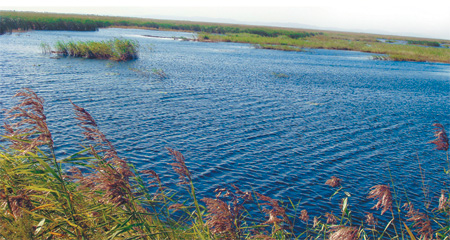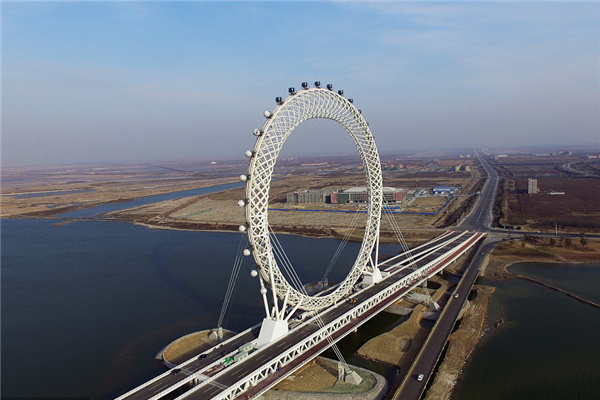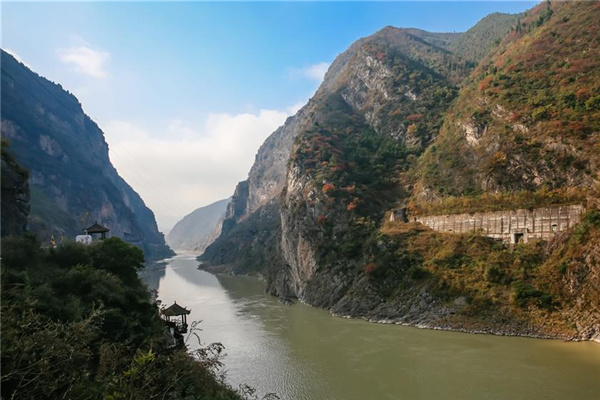


China has been making great efforts to re-draw the disappearing Sanjiang Plain Wetlands on its maps. The country's largest freshwater wetlands have changed dramatically in the face of the country's rapid agricultural development in recent decades.
Located in the eastern region of Heilongjiang province, huge sections of the Sanjiang Plain Wetlands were converted by local farmers, soldiers and Zhiqing, or urban educated youth, between the early 1950s and the 1970s, responding to the central government's call to develop the Great Northern Wilderness or "Beidahuang".
The Sanjiang Plain area, a low plain that borders the Heilongjiang, Ussuri and Songhuajiang rivers, has gone through extensive agricultural development.

Today, a broad sweep of rice paddies and farmlands stretch toward the horizon. Large wilderness areas became rich black farmlands. The Chinese people gave a new name to the region: "Beidacang" - the Great Northern Grain Barn.
According to statistics, annual grain production reached 42.3 billion kg in 2008 of the country's total 528.5 billion kg in grain production last year.
Beidahuang, which has 5.5 million hectares of fertile land, has become China's largest grain production base, growing more than 138 billion kg of grain for the country over the past six decades.
After half a century, the Sanjiang Plain Wetlands tell a very different story. Extensive agricultural development and population growth have resulted in a considerable loss of wetlands.
The Sanjiang Plain contains the largest area of wetlands in China. It contains six national wetland reserves and 10 provincial wetland reserves.
But they are disappearing at a frightening speed. After more than 50 years of economic development, the area of the Sanjiang Plain Wetlands decreased by 4.32 million hectares, or nearly 80 percent. As a result, only 1 million hectares of wetlands can now be seen on the map of the Sanjiang Plain.

The wetlands, often referred to as the earth's "kidneys", have played a significant role in water purification and conservation, as well as the prevention of erosion and flooding.
Worsening droughts
Since the 1990s, the Sanjiang Plain area, with a total arable land area of 3.5 million hectares, has suffered worsening droughts.
The worst drought struck as much as 40 percent of its farmlands, and there are now more than 808,000 hectares of farmland that are vulnerable to droughts.
Scientists said an increase in droughts, floods and sandstorms afflicting northern China in recent years are closely linked to the shrinking wetlands.
Related ecological damage has caused economic losses equal to 4 percent to 8 percent of the country's GNP, according to statistics.
"As the country's largest ecological province, environmental protection in Heilongjiang province has huge effects on northeastern and northern China," said Sun Yao, vice governor of Heilongjiang province.
Many rivers and water systems in Heilongjiang reach neighboring Russia, so the ecological effect stretches beyond China's borders, he said.
Sun said Heilongjiang, especially the Sanjiang Plain, also is important to China's food and energy security future.
Experts said the wetlands in Sanjiang Plain are considered globally important and represent one of the more important breeding sites and migratory routes for waterfowl in northeastern Asia.
The wetlands are also significant for the numbers and species of globally threatened waterfowl.
The Chinese government has realized that it must speed up its efforts to save its dwindling wetlands.
A pioneer of wetlands protection in China, the Heilongjiang provincial government has banned any cultivation and excavation of wetlands since 1999.
The 2003 Heilongjiang Wetlands Regulations gave official authority for wetlands management to the Heilongjiang Provincial Forest Department (HPFD).
Farmland-to-wetlands
With funding from the National Development and Reform Committee, HPFD is managing a project that will restore 150,000 hectares of farmland to wetlands and replant 68,500 hectares yearly by 2010.
To better protect the wetlands, the Sanjiang Plain Wetlands Protection Project has been under way since March 2007, co-financed by the Heilongjiang provincial government, Asian Development Bank and Global Environment Fund.
The project is expected to cost about $55 million, including $12.14 million in Global Environment Fund grants and $15 million in loans from the Asian Development Bank.
"The project is to promote sustainable use of natural resources through integrated conservation planning and to improve the well-being of local communities," said Robert Wihtol, China director of the Asian Development Bank.
The project is targeting 13 counties, including six nature reserves within five contiguous watersheds.
Yoshiaki Kobayashi, a water resources management specialist for the Asian Development Bank, said the project will involve 11,900 hectares of new forest plantations.
Already, 8,457 hectares of new forests have been planted, he said. The project also involves maintenance of about 43,700 hectares of existing forest lands.
"Forests increase the water retention capacity of the lands and mitigate soil erosion, which is the first step of wetlands protection," Kobayashi said.
Kobayashi said the prospect of a net annual income of $210 to $256 per hectare from dry-land grain production (wheat-soy-corn) has served as a strong motivator for farmers to expand the farmlands in any way possible, including draining the wetlands.
Meanwhile, pesticide and fertilizer pollution, burning, grazing and other agricultural practices within or near the natural reserves have adversely affected the area's ecology, according to a recent Asian Development Bank report.
"Alternative livelihoods for these farmers who are affected by the farmland-to-wetlands plan must be provided to discourage such harmful natural resource exploitation in the wetlands," Kobayashi said.
Pilot projects
Qixinhe National Nature Reserve, located in Baoqing county in the Sanjiang Plain, is one of six pilot natural reserves under the Asian Development Bank project.
The local bureau has been converting farmlands to wetlands since 2005. The plan calls for a total conversion of 400 hectares of farmlands to wetlands.
The project has faced criticism at a time when increasing prices for agricultural products make farmers reluctant to restore their lands to protected wetlands.
So local officials have traveled to each home to negotiate with farmers and inform them of the importance of improving the environment.
Wang Lansheng, a 62-year-old farmer living at Qixinghe village in Baoqing county, was among the first farmers in his region to become involved in the farmland-to-wetlands project.
Wang said he grew crops himself on his 1.5 hectares of land in the 1960s.
"Unfortunately, there were either droughts or floods in the past, and we would harvest nearly nothing after a year of hard work," he said.
"I quit my previous farmland in 2005, responding to the government's encouragement. In return, they allocated me another plot of farmland of 0.8 hectares. Since then, I have started a new life," Wang said.
Wang said he does not fully understand the science behind efforts to protect the wetlands.
"I cannot understand what climate change is, and I don't know about environmental protection," Wang said.
"We farmers just rely on Heaven for food generation to generation. When the authorities told me the farmland-to-wetlands project is to flatter God, I decided to have a try," he said.
Wang won his gamble. Today, he earns as much as 100,000 yuan each year by growing "green" fruits and vegetables on his new plot of land, he said.
"I bought a big apartment in the county, and my wife and I usually spend holidays there," he said.
So far, the Qixinghe National Natural Reserve has restored about 440 hectares of farmlands as wetlands. The project has received about 860,000 yuan in compensation, which has been used to construct water facilities and other infrastructure.
Farmers must be compensated for lost income and provided replacement land, said Ma Zhong, dean of the School of Environment and Natural Resources at Renmin University of China.
Li Xiaoyun, an expert at China Agricultural University, said that, based on local conditions, different regions can choose alternative ways for residents who are affected by the farmland-to-wetlands project to earn a livelihood.
China this year began a second survey of the country's wetland resources. Over the next four years, officials will explore how to best compensate landowners and manage project funds.
The Government's National Basic Farmland Protection Policy states that some farmlands in the Sanjiang Plain wetlands are designated as basic farmlands that cannot be restored to wetlands.
Experts said the goal is to achieve the most workable balance between wetlands restoration and agricultural production.
"After all, lessons learned and models created from the pilot wetlands restoration at Sanjiang Plain will be replicated for other wetlands," said Kobayashi of the Asian Development Bank.
Protecting wildlife
Wetlands cover only 6 percent of the total area of earth, but they provide living habitats for more than 20 percent of the world's species. In China, half of the country's 40 protected birds live in the wetlands.
Still, under the pressure of a booming economy and a fast-growing population, coastal wetlands in China shrank about 50 percent in the past 50 years.
So far, the total area of wetlands in China is about 65.9 million hectares, accounting for 10 percent of the world's total amount.
Yuan Jiming, deputy director of the Wetlands Protection Center at the National Forestry Administration, China's wetlands management body, said China has paid more attention to wetlands protection in recent years.
China in 1992 ratified the Ramsar Convention, which is an international treaty for the sustainable use and conservation of wetlands. China allocated $1.4 billion for wetlands protection between 2005 and 2010.
China also launched the National Program for Wetlands Protection Engineering, which plans to restore 1.4 million hectares of wetlands and create 713 wetlands reserves by 2030.
A recent popular Chinese movie, If You Are The One, has raised public attention about the Xixi Wetlands in Zhejiang province, which was one of the movie's filming locations.
Experts said the film illustrated that public awareness of the need to protect China's wetlands is growing, too.
(China Daily 11/09/2009 page12)













